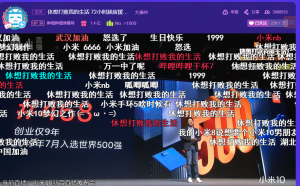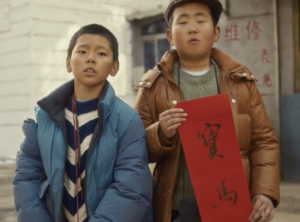
An awkward product placement in “Transformers: Dark of the Moon” (2011)
Brands, as we know them today, have a relatively short history in the People’s Republic of China, and few domestic firms have managed to gain respect and recognition — much less a strong foothold — outside the country. Yet the domestic consumer scene is thriving, with retail sales expected to overtake the U.S. for the first time this year, reaching $5.6 trillion, according to research firm eMarketer.
Likewise, marketing in its many forms is fairly new to China, and while some brand integration efforts have been derided as unsophisticated or clumsy, there are opportunities, innovations, and challenges unique to the country. It is also important to understand that brand integration sometimes operates in a legal gray area, and broader political concerns may spill over into the entertainment sector, leading to rapid regulatory changes and censorship.
In this two-part introductory report, we’ll look at some key issues relevant to marketers planning brand integrations for the Chinese market. This week, we’ll highlight the critical roles of online distribution and the mobile internet, as well as the wide variety of formats available for brand integration, some of which are specific to China. Next week, we’ll offer an overview of the laws and regulations that apply to the entertainment and advertising industries and that brand owners should keep in mind.
China’s Digital Rise
China is in the midst of a digital entertainment boom, thanks to the aggressive expansion efforts of its leading internet companies, with the effects most profound in the mobile space.
In China, as elsewhere, consumers are moving away from traditional media formats to focus their attention on digital, and especially mobile, content. Chinese consumers now spend an average of 4.7 hours per day on mobile entertainment alone, according to QuestMobile*, a trend fueled by the great variety of content available digitally and the expansion of high-speed mobile data connections to reach even the most far-flung rural consumers.
Multiple Channels for Brand Integration
Beyond traditional film and television, abundant marketing opportunities exist via streaming video on demand, short-video apps such as TikTok (Known in China as “Douyin”), livestreaming and e-commerce platforms, video games, music, and sports.
Influencers play an even bigger role in China than in other markets, since consumers prefer to discover products through word-of-mouth and referrals from trusted sources. Chinese influencers not only endorse products but also often sell them to consumers through their own online shops on established e-commerce platforms.
More Paying Subscribers, More Original Content
Most digital entertainment is free to users and supported by ads, but, as elsewhere, the future looks increasingly ad-free, putting brands owners under pressure to integrate their marketing more effectively with content.
Take China’s leading online video platform, Baidu’s iQiyi, as an example. IQiyi has an estimated 543 million monthly users, and reported a 58 percent year-on-year increase in paying subscribers in 2018. (The exact figure recently surpassed the 100 million mark.) And by next year, iQiyi will likely spend more on original content than the combined total of China’s six major broadcasters, a group that includes the state-run giant China Central Television (CCTV).
IQiyi is also investing heavily in online gaming, as well as short video and e-reading platforms, with the goal of becoming a “one-stop entertainment platform,” according to Chief Content Officer Wang Xiaohui. IQiyi’s main competitors in the video streaming space — Tencent Video and Alibaba’s Youku — are owned by the country’s two biggest internet companies, which are following similarly aggressive strategies to capture consumer attention.
Innovation in Brand Integration
Entertainment marketing is rapidly evolving in China, with content producers and brand owners very open to experimenting with technology and creativity to link content and commerce. One review of brand integration by Chinese industry news outlet Huayu identified 15 types of brand placements frequently used in Chinese media, ranging from traditional pre-roll ads to more recent innovations, such as tech-driven pop-up ads that tie into plot points in a drama as it unfolds onscreen, or mid-broadcast interstitials that see actors from a show endorsing a product while still in character.
On China’s super-popular reality shows, brands are promoted not only through traditional methods such as title sponsorships and product placements, but also through more direct integrations involving the stars and brands. Talent competitions such as the hugely popular “Rap of China” feature contestants performing in music video spots promoting some of the show’s sponsors, including foreign brands such as McDonald’s and Nivea.
What Consumers Want
Yet there is still a long way to go. While there is a perception that Chinese consumers are willing to put up with all manner of advertising in exchange for free content, a 2017 survey by China Youth Daily presented a different view. More than half of the respondents felt that product placements are too pervasive, and nearly half found some to be embarrassing or even capable of ruining their viewing experience. Viewers, however, are more willing to accept branding that is inserted in humorous or inventive ways, such as the pop-up ads that correspond to actions taking place on-screen. A survey by iResearch found a whopping 92 percent of viewers of the hit costume drama “The Story of Yanxi Palace” approved of this type of marketing.
Our forthcoming newsletters will further explore these issues in greater detail. Thanks again for reading, and stay tuned for more!
_____
*Entertainment is defined broadly to include “e-reading, music streaming, online karaoke, video streaming, mobile gaming, live streaming, and of course, short videos that are taking the world by storm.”






